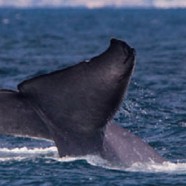
The blue whale swimming in the waters off the California coast, the Houston toad hopping around the woodlands of Texas, and the piping plover skittering around the dunes of Cape Cod. Three species share one distinction: They are officially endangered. You’ll find them among more than 1,000 animal and plant species on the Endangered Species List. The list is a storied point of contention among political, business, environmental, and scientific groups, and Ben Jesup ’82, an attorney with the Solicitor’s Office of the Department of the Interior, happily deals with it every day.
“I spend almost all of my time counseling the Fish and Wildlife Service (FWS) on questions related to listing a species or removing it,” says Ben, who specializes in Section 4 of the Endangered Species Act (ESA). “This law provides for the conservation of species at risk of extinction, protecting biodiversity, which Congress in 1973 recognized as having ‘esthetic, ecological, educational, historical, recreational, and scientific value to the Nation and its people.’”
“Listing is what starts you down that path,” says Ben. “Some people argue there’s too much work in protecting the species already listed. Why not spend resources protecting listed species rather than listing more? One answer is that for some species, listing can make all the difference. It’s important that the FWS has the resources and staff to identify the species most at risk so that the protections of the Act can be brought to bear.”
Listing a species is an involved process. The first step is making the “candidate list” before consideration for either the “threatened” or “endangered” species list. And an ESA provision gives the public the ability to sue the government for noncompliance with the law. The result is what Ben refers to as “The Listing Wars” in a recent paper he wrote. (“Endless War or End This War? The History of Deadline Litigation under Section 4 of the Endangered Species Act and the Multi-District Litigation Settlements”)
In the Listing Wars, environmental groups and other stakeholders routinely sue Fish and Wildlife for falling behind on listing action deadlines. When FWS focuses on lawsuits instead of listing activity, it falls further behind and builds a huge backlog. Throw in limited resources and budgetary issues, and the result is that courts make listing decisions with little regard for the conservation priority of the different species—not what the law intended.
“Some environmental groups, not all, are inherently skeptical of what happens at a political level in Washington,” says Ben, who has worked for the Solicitor’s Office for 17 years. “They assume the people running the government won’t act because they’re worried about the political impact on their futures. On the other hand, many people in the industry think the FWS is a bunch of green, tree-hugging maniacs. Fish and Wildlife inevitably gets stuck in the middle. We are sued by all sides! This doesn’t mean that FWS is infallible, but the litigation keeps us on our toes.
“Regardless of what decision we are making—to list a species, to delist a species, to designate critical habitat, or to exclude areas from critical habitat—we have to show that the science supports our decision, and that our decision is consistent with the legal requirements of the Endangered Species Act. My job is to help FWS navigate the pitfalls and hurdles to make legal decisions that are likely to be upheld in court, and to help the Department of Justice defend FWS if challenges materialize.”
In 2010, the government took a new approach to breaking the cycle of litigation that kept the FWS from moving forward. The FWS filed a petition with the Multi-District Litigation Panel to centralize 20 deadline cases filed by two large environmental groups under one judge in one court.
“One frustration is that a judge looks only at the particular case before him or her,” says Ben. “The FWS, however, is looking at the big picture: how to make the whole program work, not just what needs doing in this case. The judge only sees a missed deadline, and the natural reaction is issuing court orders with very short time frames. This doesn’t serve the highest conservation priorities from the FWS point of view. Centralizing the cases in front of one federal judge would allow us to present the big picture and require the judge to take a 40,000-foot view.”
The petition was accepted and the judge referred the centralized case to a mediator. Mediators have no power to issue directives; they help parties reach some accommodation by channeling conversations and providing a sounding board.
“When two parties are litigating, their tendency is to talk and not listen,” says Ben. “An effective mediator helps people listen and understand what they each have to win or lose. Mediation is a freewheeling process that helps the parties decide how to handle the problem and hammer out a compromise.”
Nine months after the government and two environmental groups entered the mediation program, the parties filed two settlement agreements with the court. The agreements focused on clearing the backlog of candidate species, which gave the FWS some breathing room to get its “real” job done, while also giving the environmental groups confidence that FWS would fi nally resolve the status of all of the candidate species.
How were the parties able to reach this agreement? “Both sides wanted to move species off the candidate list,” says Ben. “The FWS wants to comply with the law, get species off the candidate list, and make final listing determinations. Having a big candidate list is not good for the FWS in terms of doing its job.”
All parties recognized that time spent on litigation meant delays in listing species. Both sides entered the mediation with some leverage. For the government, it was having succeeded in centralizing the cases; for the environmental groups, it was the law and the historical precedents. People working on the governmental side also had credability in the eyes of the environmental groups.
Ben hopes the agreement sets a precedent for future disputes, leading to a decrease in litigation and a movement toward more informal resolutions. He says “the jury is still out,” however, on the long-term effect.
“This case could significantly change the dynamic between parties, change the track we’ve been on, improve the effi ciency of the listing process, and, ultimately, help protect biodiversity,” says Ben. “There are some good signs, and lots of challenges, still. But this case was successful if you accept the notion that protecting endangered species and biodiversity is important for any number of reasons—practical, ethical, even spiritual, if you want to go in that direction. Listing a species is the fi rst step toward activating the regulatory mechanisms of the ESA, which in some circumstances, not all, can provide meaningful protection and reduce extinction risk.”
Ben’s father was an amateur herpetologist, and Ben grew up in a house filled with snakes and turtles. He developed a passion for bird watching, and during his years at Milton, Haverford College and New York University Law School, he became increasingly interested in environmental issues. Today he lives outside of Washington, D.C., with his wife and daughter, and he has recently added insect photography to his bird-watching adventures. He feels content and fulfilled working in a public-service role that draws on his strengths as a lawyer and his personal interests.
“In general, I get to work on things that I would have spent my free time reading about,” says Ben. “I’ve always been interested in natural history and biodiversity. I am fascinated by evolution and natural selection, and the people I work with are smart and interesting. My day-to-day work is intellectually engaging, and it’s fun.”
–Liz Matson





